Lucifer Within Us (PC) Review – Opportunity, Means and Motive
Lucifer Within Us is a deep murder mystery, where you are given the tools to solve a series of murders via some sweet timeline manipulation. Its really cool. The Finger Guns Review.
Lucifer Within Us [STEAM], from Kitfox Games, is a detective game in the very truest sense. Where many games present you with little mysteries and then allow you to solve those mysteries by rote pressing of a few buttons, or by using an x-ray scanner to scan everything, find the clues and bingo, Lucifer Within Us seeks to present you with a small series of in-depth mystery cases and actually give you the tools and freedom to solve them for yourself.
Lucifer Within Us reminded me of the classic Sean Connery movie, The Name of The Rose, with its abbey under the shadow of multiple murders, and a brother, or in this case sister, of the cloth being brought in to solve them. It manages that same self-contained narrative that works so well in confined spaces for Poirot and Sherlock Holmes.
And it’s through the tried and tested logical tools of Dr Holmes that Lucifer Within Us creates its gameplay and mechanics; scrubbable timelines for suspects’ testimonies; tasking you with establishing opportunity, means and motive, via deduction and contradiction. It’s frightfully clever and intuitively designed to make you actually feel like a real sleuth. Now I can’t just say all that opinion without basing it on some irrefutable evidence, so please take a look at my testimony, and let’s see if I can’t convince you that Lucifer Within Us is guilty of being really damn good.
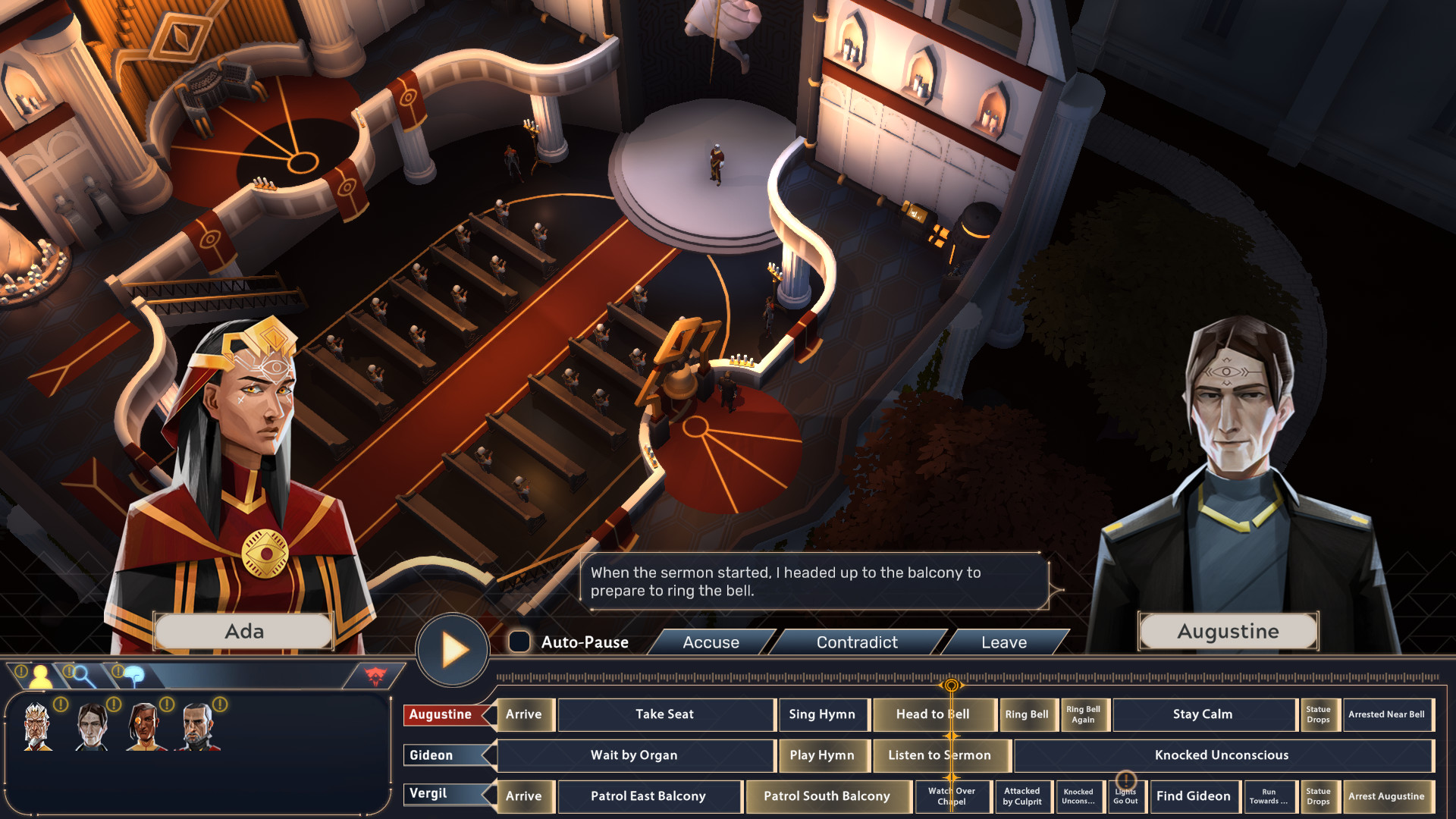
Arriving at Saint Walpurga’s Abbey, Sister Ada is an exorcist, summoned to solve a murder. High Priestess Mother Miriam is the victim, and her head has exploded during a strange ritual. Now that’s only possible because this isn’t just any abbey, it’s a cybernetic abbey full of devouts who are all cybernetically enhanced in some way or another, and Sister Ada isn’t just any exorcist, she’s a digital exorcist, able to use those same cyber upgrades to peer into her target’s psyches and gaze upon their baser urges, and exorcise them of their daemons. Useful for a detective.
Murder follows murder, on this terrible day at St Walpurga’s, and we are taken from the ritual chambers to the graveyards, and finally the chapel, to solve three cases across the length of your playthrough. For despite multiple murders, the Abbot is more concerned with appearances and the celebration of Walpurghisnacht (read mass) than he is in listening to the advice of one such as Sister Ada that there may be more at play here than simple human sin. All it takes for things to go wrong is for the weak-minded in power to ignore sound advice and evidence. Funny that, the religious ignoring evidence. That would never happen.
The narrative of Lucifer Within Us will easily remind you of The Name of the Rose, with its series of murders in an abbey, or possibly the first book in the Shardlake series. It’s perfectly self-contained, giving each case a closed room mystery feel, and the whole abbey as the closed world within which’s walls everything takes place.
Every character up to and including Sister Ada is written with care and precision, and a believability that will draw you into the story very quickly. Sister Ada is the outsider learning the world and its inhabitants, as are you the player. This made she and I accomplices almost immediately, where for example having her already familiar with the abbey and its people would not have achieved this.
She appealed to me directly, despite being an exorcist, by also being a sceptic. I find it very easy not to trust the word of a number of religious-types in an abbey, and her attitude to them all suited me no end.

A good portion of the first case, that of the exploding head, serves as the tutorial. Sister Ada explains the methodology and the gameplay mechanics and it’s like listening to Sherlock Holmes explaining deduction and exclaiming its elementary!
In each case you have a closed room, a fresh body, and a number of suspects (usually 2 or 3). It’s your job to gather multiple types of evidence. Firstly and most simply, physical evidence, gleaned by walking around the room and inspecting outlined items, bodies, weapons etc and then noting them in your file.
Then comes Testimony – the real meat of Lucifer Within Us. By approaching and speaking to each suspect you can question them on their movements and whereabouts during the scope of the murder event, and each suspect will lay out a full timeline for you broken down into time periods and statements. As this happens, the present game world is replaced by a re-enactment of their movements prior to the crime. You have a fully controllable scrubbable timeline, as if you were in control of your own video editor of events. Layer this with the next testimony and the next, and you see areas where statements disagree, or where one suspect corroborates another.
You can then ask about each and every statement, and when you find a contradiction, call them out on it and click the section of the timeline from another’s testimony that opposes it. Cases are split into Sherlock’s rules of investigation; Deduction – if two statements don’t tally, one or both are false; Induction – base your theory on the evidence, and when you are ready; Abduction – filling in the gaps with your own imagination.
When caught in a lie, a satisfying screen will pop up, and the suspect will have to backtrack, rework their story to fill the areas where they were less forthcoming, or caught out. The visual re-enactment will alter to the new version of events. You will also crack their psychological sanctum, their third eye. Remember we said that Sister Ada was an exorcist, well part of her power is to glean psychological information/evidence from suspects once their minds have been weakened, ie their motives.
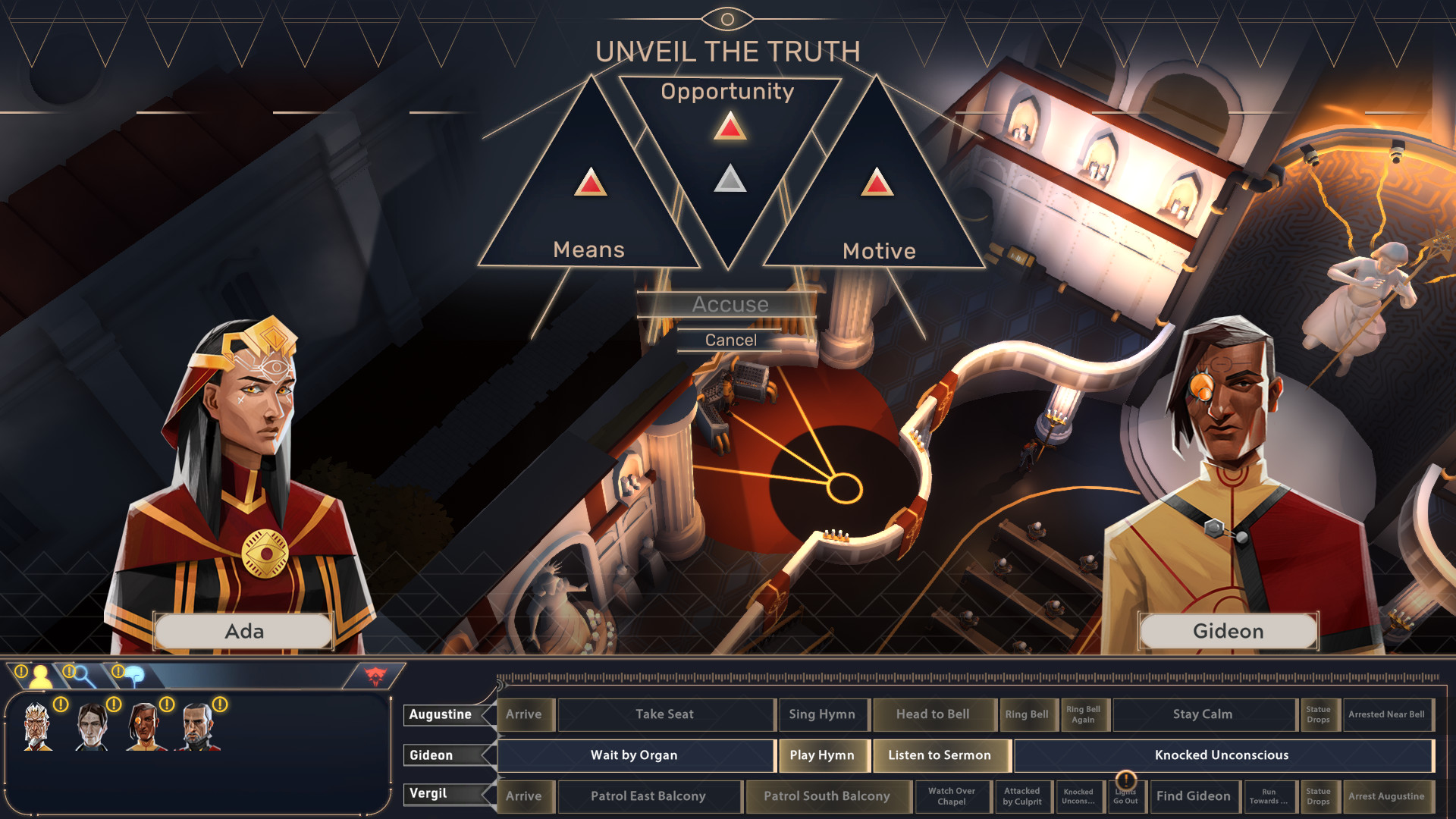
You are trying to build up enough evidence that you can make the leap beyond contradiction, to accusation. You must establish opportunity, means and motive, before an accusation will stick. Opportunity comes from your deft manipulation of the timeline, where and when the suspect could have done the deed; means requires physical evidence be presented; and motive requires the psychological evidence you gleaned from their mind.
It’s like the manual on interrogation and mystery solving has been completely gamified, and not as in scores and pointless tasks. I mean its been broken down from a somewhat instinctive process, that we all wonder about, into its exact component pieces, and laid out in full intuitive UI for you to use and deduce from.
Imagine if you read the latest crime novel and you kept diligent notes, able to put together a timeline of events, able to cross reference that with each different witness or suspect’s version of events. And then stop at each section, ask questions about each and every stage of the event, quiz them on evidence you find that disproves their statement, and then catch them in a lie using another’s account. It’s like a mystery novel reader’s dream.
When you’ve solved a case, and got your suspect to confess by establishing opportunity, means and motive, then you must look inside their mind once more and speak the name of the deamon that possessed them. In Lucifer Among Us, the crimes are never only those committed by fallible humans, but always those goaded further by the machinations of a manipulative daemon. I found this mechanic interesting (and narratively it ties together the murders and the night itself) but ultimately unconvincing – we all know humans are perfectly capable of committing heinous acts, without the fictious addition of a daemon to explain why. We are capable of listening to our own inner voices and obeying them within any demonic intervention.
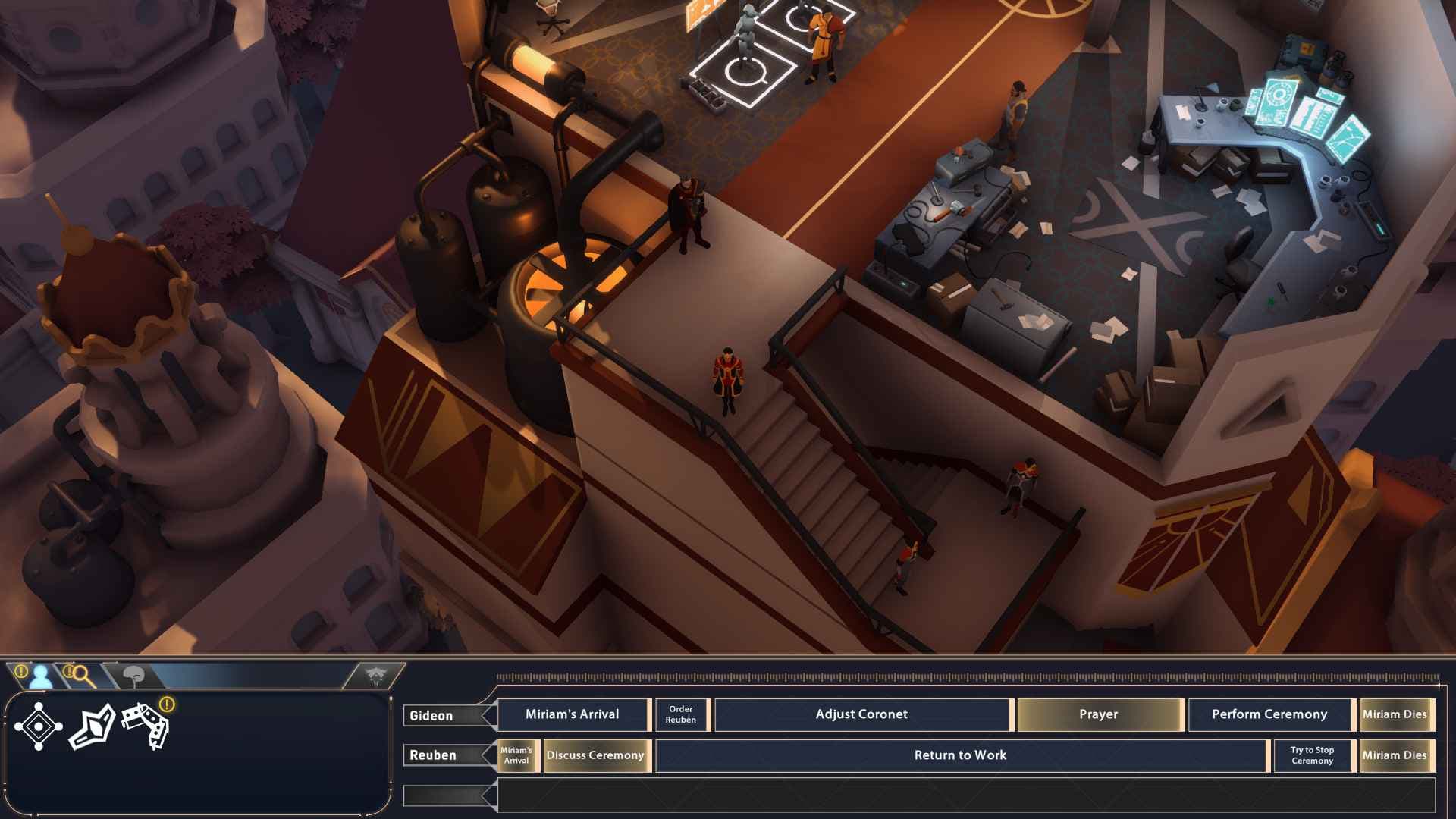
I tell you now, lying scum the lot of them. Everyone is lying, often not for much point beyond embarrassment or minor infractions, but everyone is doing it. Just go in assuming that most of their first testimony is false and you’re good.
I took to browsing the entire, usually small, isometric area, collecting every piece of physical evidence I could find. Only once I had everything did I start interviewing the suspects, and then contradicting and teasing out the truth in their timelines. Don’t expect much from the actual physical gameplay where you control Ada, what’s front and centre here is the timeline manipulation, the deconstruction of false testimonies, the clever constructs of multiple versions of the same events.
The conversations are presented in a classic visual novel style with both character’s still image art on either side of the screen, and the game world in the centre, timeline at the bottom. The artwork is strong, evoking Dishonored in its stylisation. The graphics in the game world are pretty basic, but they are nice enough and serve their purpose.
Though much of the expository dialogue and the testimonies are fully voiced, it was a shame that much of the questions and explanatory dialogue wasn’t. There were also a handful of times when one particular line wasn’t voiced, in the middle of a conversation that otherwise was. I would also say the text speed is very slow, so I was forever clicking through to just show the whole sentence. It’s just a click of spacebar, but text speed should at the very least be as quick as the words are being spoken, and if they aren’t even being voiced, there’s not much point to not revealing the whole sentence.
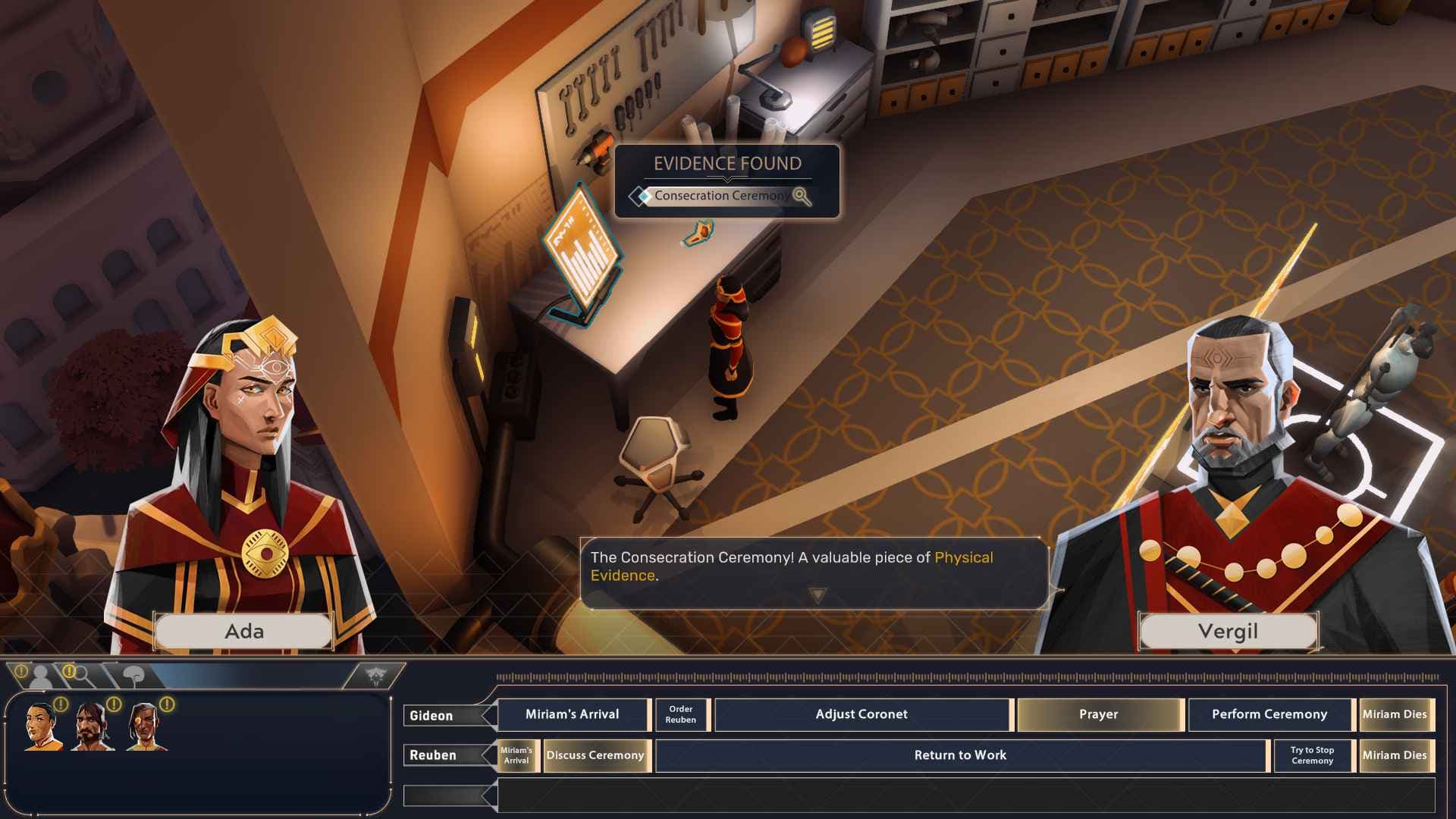
Despite one or two difficulties solving cases, which were entirely my own fault for not thinking outside the box enough, by the end I was left with the bittersweet feeling that Lucifer Within Us was too short and I wanted more. There are three cases, and each will take you around an hour to complete, say 4 hours total, unless you get stuck and hopelessly try combinations for a while like I did. It’s not especially hard, but it does require concentration and a bit of lateral thinking. I would have really enjoyed another two cases at least.
I hope they release DLC of another case or two. I would happily play earlier mysteries in the life of Sister Ada, before she ever came to the abbey. Lucifer Within Us also ends with an interesting finale, one that I won’t spoil, but that leaves plenty of possibility for further cases and mysteries, and possibly a sequel in the surrounding township.
The scenario writer or team has shown a deft hand at handling all the minutiae of creating a mystery without sugar-coating or fudging over anything. It would be impossible to do so, when you have laid out the tools and gameplay framework so carefully and so well. Where would the hole in the case remain when you have had to think out and write and animate every scenario?
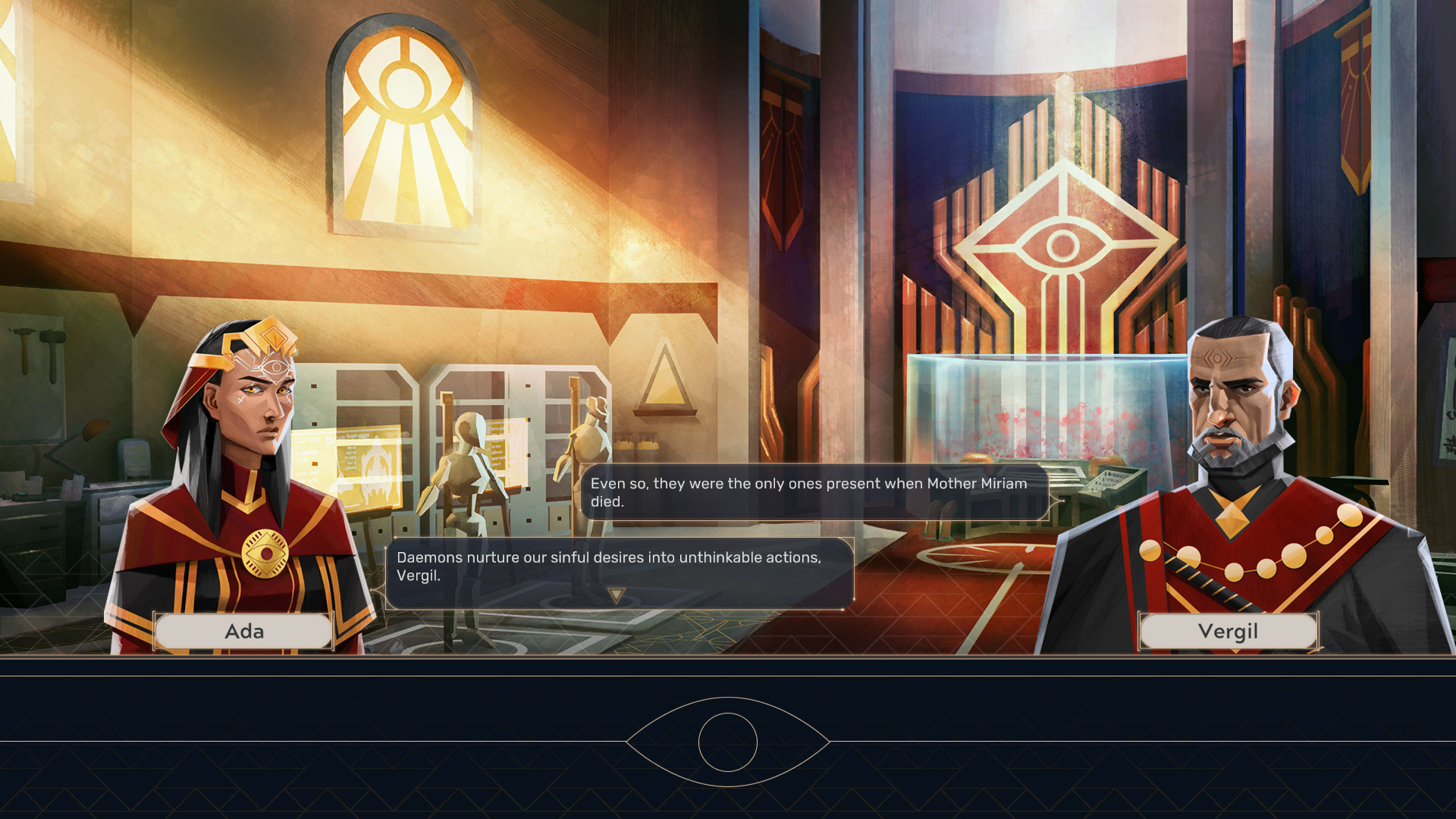
Lucifer Within Us is a deep detective game in a unique cyber abbey setting, that breaks down the tools and logical methods of the detective into intuitive UI timelines and mechanics. It creates a fascinating story that had me engrossed throughout, and when I got stuck had me unable to think about anything else until I had got back to the game and found the answers. If you get the opportunity and have the means, I hope I’ve given you the motive to give Lucifer Within Us a try. I suspect you will have a blast. Games this cerebral don’t come along that often.
A deep cyber detective tale, with a unique take on the tools of the trade, Lucifer Within Us is special for its use of intuitive timelines and mechanics to control and manipulate every part of the mystery. Add an engrossing narrative and interesting characters, and you have a recipe for a short, but very cerebral experience.

Lucifer Within Us is out now on PC (reviewed) via Steam.
Developer: Kitfox Games
Publisher: Kitfox Games
Disclaimer: In order to complete this review, we were provided with a promotional copy of the game. For our full review policy, please go here.
If you enjoyed this article or any more of our content, please consider our Patreon.
Make sure to follow Finger Guns on our social channels –Twitter, Facebook, Twitch, Spotify or Apple Podcasts – to keep up to date on our news, reviews and features.



